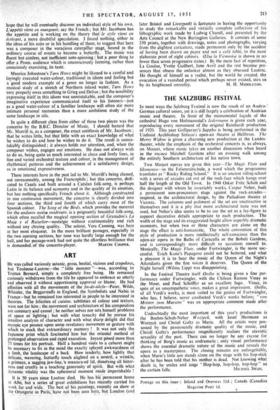THE SALZBURG FESTIVAL
IN most ways the Salzburg Festival is now the result of an Austro-' German cultural union, yet it is still largely a celebration of Austrian music and theatre. In front of the monumental façade of the cathedral Hugo von Hofmannstal's Jedermann is given each year, reproducing every movement of the original Reinhardt production of 1920. This year Grillparzer's Sappho is being performed in the Undinist Archbishop Sitticus's open-air theatre at Hellbrun. The Merry Widow is given a charming new production at the Landes- theater, while the emphasis of the orchestral concerts is, as always, on Mozart, whose music takes-on another dimension when heard in the rococo Mirabell Gardens after an evening walk among the entirely Southern architecture of his native town.
Two Mozart operas are given this year—The Magic Flute and Idomeneo—in the Felsenreitschule, a word which the programme translates as " Rocky Riding School." It is an ancient riding-school with a series of arcades cut out of the rock-face which hangs over half the length of the Old Town. In 1948 Oskar Fritz Schuh and the designer with whom he invariably works, Caspar Neher, built a permanent non-proscenium stage against the rock-arcades- inspired, in the architectural design, by the Palladium theatre at Vicenza. The columns and pediment of the set are unattractive in themselves and it is a pity that more architectural taste was not used, but Neher's idea seems to be to use the set as a lay-figure to support decorative details appropriate to each production. The width of the stage and its exaggerated height allow superbly dramatic moments, but when two or three characters are alone on the stage the effect is anti-humanistic. The whole convention of this style of production is more intellectually self-conscious than the open-air opera in the Baths of Caracalla or the Boboli Gardens, and is correspondingly more difficult to accustom oneself to. Musically, The Magic Flute, under Furtwangler, is the more suc- cessful. Erich Kunz's Papageno could not be bettered, and what a pleasure it is to hear the music of the Queen of the Night's Attendants given the fine voices it deserves. The Queen of the Night herself (Wilma Lipp) was disappointing.
In the Festival Theatre itself (hello is being given a fine per- formance under Furtwangler, with the Chilean Ramon Vinay as the Moor, and Paul Schoffier as an excellent lago. Vinay, in spite of an unsympathetic voice, makes a great impression. Quito,. of all Verdi's works, is most suited to the genius of Furtwingler, who has; I believe, never conducted Verdi's works before; " von Meister zum Maestro" was an appropriate comment made after. the performance.
Undoubtedly the most important of this year's productions is the Boehm-Schuh-Neher Wozzeck, with Josef Hermann as Wozzeck and Christi Goltz as Marie. All the artists were pos- ' sessed by the passionately dramatic quality of the music, and Christl Goltz's performance magnificently realises the atavistic sexuality of the part. There can no longer be any excuse for thinking of Berg's music as undramatic ; only visual performance' shows the essential dramatic nature of the music and reveals the opera as a masterpiece. The closing minutes are unforgettable, when Marie's little son stands alone on the stage with his hop-stick after he has been told that his mother is dead. Not knowing what death is, he smiles and sings " Hop-hop, hop-hop, hop-hop" as






























 Previous page
Previous page